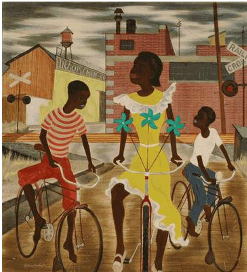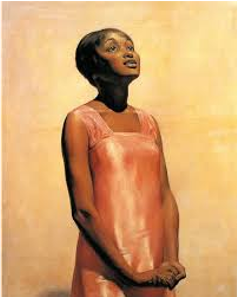I am Martha Brown, president of RJAE Consulting. As I grow in my understanding of how white supremacy manifests in myself and the world, it becomes more evident in my arts evaluation work.
My story concerns a program evaluation in an art museum. Art museums are known white spaces; the American Alliance of Museums reported that just 9 percent of core museum visitors are people of color. During this evaluation, I observed and recorded interactions between museum docents and students. Docents were white, middle-to-upper class, over-50 volunteers. Most second-grade students were children of color and attended Title I schools.
Many art works the docents discussed represented the traditional white European canon. Sometimes works by artists of color were discussed, but docents did not consistently note them as such. Given that the theme of the tours was how artists use art to tell stories, docents buried opportunities for both artists and students of color to tell their stories. Their colorblind approach eradicated the chance for students of color to see themselves in the works or become an artist like Augusta Savage. The docents’ whiteness was likely the reason why works by and about people of color were passed over.

(American, 1919-1980)
Ridin’ High (1947)
Currently hung in Norton Museum of Art
My challenge was to let go of white solidarity, which Robin DeAngelo defines as “the unspoken agreement among whites to protect white advantage and not cause another white person to feel racial discomfort by confronting them when they say or do something racially problematic” (p. 57). So, I spoke to one docent as we watched another docent discuss a Normal Rockwell painting of upper class, elderly white people. The students had no idea what many of the objects in the painting were because they had never seen them. I asked, “Why isn’t she talking about the painting right next to her (Ridin’ High)? Or the portrait of Ruby Green Singing? They could better identify with those works.” This docent heard me, researched Ridin’ High, and included it in her next tour. In that instance, I broke white solidarity without penalty. But I cannot predict a comparable response from the other docents or program managers.

(American, 1887-1975)
Ruby Green Singing (1928)
Currently hung in Norton Museum of Art
When I raise issues about equity or cultural relevance in my reports, my clients often edit or delete my words. I wrestle with these difficult questions as I journey toward anti-racism: How do I have this conversation in a way that doesn’t send my clients retreating into the bowels of white fragility? Do I settle for the watered-down edits that make the recommendations about cultural relevance easier for my clients to swallow? I am only sure of this: saying or doing nothing perpetuates white supremacy, and I can’t do that anymore.
Rad Resources
“Black People Don’t Go To Galleries” – The Reproduction Of Taste And Cultural Value By David Osa Amadasun
Can Art Amend History? Artist Titus Kaphar TED Talk
The American Evaluation Association is exploring White Privilege Week with our AEA colleagues. The contributions all this week to aea365 come from AEA members. Do you have questions, concerns, kudos, or content to extend this aea365 contribution? Please add them in the comments section for this post on the aea365 webpage so that we may enrich our community of practice. Would you like to submit an aea365 Tip? Please send a note of interest to aea365@eval.org. aea365 is sponsored by the American Evaluation Association and provides a Tip-a-Day by and for evaluators.

Thank you for this. I just have one piece of feedback maybe you’ll consider- I think as white people, we need to be careful to avoid speaking for people of color. Perhaps it’s just the wording here, because we all definitely can and should continue to bring attention to how important it is especially for young POC to feel seen and represented in all of society, but I don’t think it should be up to anyone else to say on their behalf what they (individually or as a group) best identify with. I hope evaluations like yours lead to better representation, and moreover hope POC are involved in the design and implementation of the evaluations themselves.
HI Jennifer! Thank you for the feedback. I’ve curated the week. We’ll definitely pay attention to that in the upcoming weeks we organize. Much appreciated!
Dr. Rita
Thank you AEA for having the first ever “white privilege” week of blog posts. And I applaud the blog authors and those who continue to lead this work in contexts and cannons where privilege rarely is questioned. There is such value and need for this work and deep potential for more courageous conversations and actions that could lead to the transformations and sustainable efforts we often speak about having.
Thank you Nicky! I appreciate your appreciation. I love your encouragement, I love you!
Thank you for the thought provoking post. Your question about settling for watered down recommendations is one I struggle with often, especially when we surface equity issues in work that was not explicitly commissioned to explore those issues. I’m grateful we’re having these dialogues and mindful of how much work there is left to be done.
Joelle
Thank you Joelle,
Let’s stay in that conversation, it has only just started!
Let’s create sooooooo much community around this, that we shift the conversation! With love.
Dr. Rita
Thanks for this Freudian typo, Martha: Normal Rockwell!
And mostly thanks for no longer doing nothing.
Vidhya
🙂 THank yo for the encouragement Vidya!